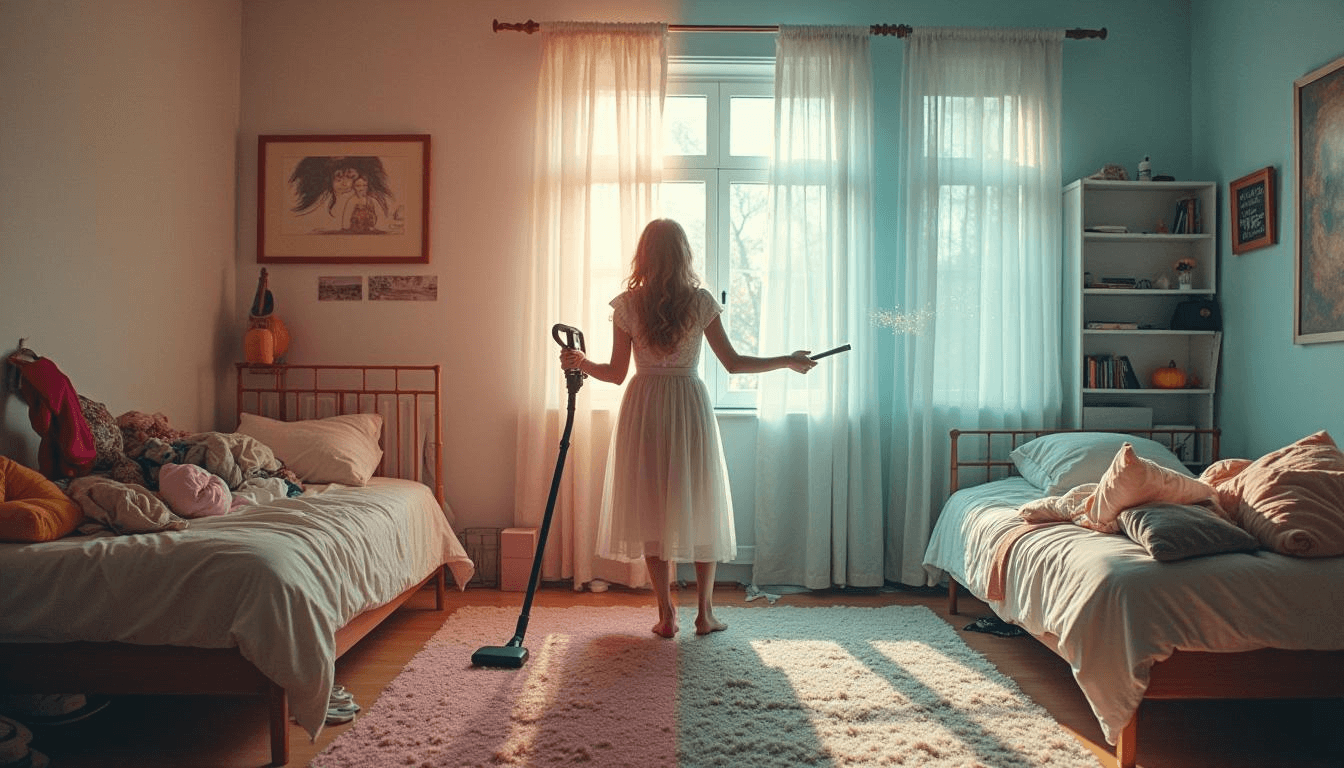How well do you grasp the complete influence of bedroom messes on your body together with your mental state?
Your bedroom functions as your sanctuary where you can achieve peace alongside rejuvenation. The accumulation of clutter creates serious disturbances within this essential place for rest. The visual disorder of a cluttered bedroom causes direct negative effects on your health and life quality that you can measure.
The Psychology of Clutter
Your senses get overwhelmed by visual clutter disorder which leads to difficulty in achieving relaxation. Your ability to read in bed deteriorates when you have laundry piles combined with papers and unfinished tasks which distract you. The perpetual visual interference from clutter creates persistent minor stress which disrupts sleep and affects mood as well as concentration.

Catastrophic disorganization within your environment strengthens your emotions of embarrassment while simultaneously generating feelings of being overly burdened. Mental weight appears through unfinished tasks which individuals represent with individual piles. Procrastination becomes a problem because of clutter which itself starts from postponing tasks.
Professional individuals who handle many obligations face special difficulties in breaking this negative pattern.
The Impact on Sleep
Scientific evidence has established that untidy sleeping areas directly interfere with quality rest. Physical disorder creates barriers which prevent you from finding proper comfort and achieving rest. The disorganized visual appearance triggers mental activity during your sleep-winding period. The disorganized environment stops numerous individuals from finding peaceful rest during the night.

Studies reveal people with cluttered bedrooms experience significantly more sleep problems than those with tidy rooms. For detailed statistics on how clutter affects sleep and wellbeing, see this research on clutter’s impact. The evidence clearly shows that an organized bedroom is key for restorative sleep.
From Clutter to Clarity: How Decluttering Helps
Ordering your bedroom space produces effects beyond visual improvement as it leads to authentic peace alongside wellbeing. Restful conditions emerge when physical and visual distractions disappear from your environment. A tidy room creates conditions for improved sleep quality and reduces stress and enhances concentration. An orderly environment creates mental clarity which enhances productivity together with creativity. The following section demonstrates effective methods to properly declutter your bedroom.
Mapping Your Decluttering Journey
Most individuals experience confusion during their bedroom decluttering process. Such feelings of being overwhelmed about this task are completely natural. The process becomes easier to handle through step-by-step guidance which transforms disorder into calmness.
Assessing Your Current Situation
The first step requires you to thoroughly examine your bedroom current condition. Identify the main cluttered zones and the particular objects behind the disorder like clothing pieces, storage overfilling, and reading material accumulation. Identifying personal clutter problems serves as the foundation to create an effective solution plan.
The first assessment lays down fundamental elements for achieving success.
Recent research shows you’re not alone in feeling overwhelmed. A Budget Dumpster survey found that 74.1% of Americans tackled a decluttering project last year, with bedrooms being one of the top spaces. However, 58.9% of people felt overwhelmed at first, mainly because they weren’t sure how to begin. Learn more about decluttering trends and statistics. Understanding these numbers can help boost your confidence to get started.
Creating a Personalized Action Plan
You should build an action plan which suits your requirements after you recognize your clutter trouble areas. Establish practical objectives alongside detailed tasks and establish a structured time frame. A well-planned roadmap functions similarly to renovation work since you require detailed plans to begin.
Breaking Down the Process
The project becomes easier to handle when you split it into smaller sections.
Attempt to declutter only one particular area at a time such as your closet or dresser or bedside table. Your success in completing smaller chunks of work will help you stay motivated throughout your project because of the zone-by-zone approach.
The project remains manageable because of this approach.
Tracking Your Progress and Staying Motivated
Record your advancement throughout the task.
Three basic tracking methods include checklists, a tracking app, and before-and-after photos as visual references. Your progress visualization creates strong motivational forces that drive you to progress further and enables you to sustain your decluttered area.
Your momentum plays a vital role in finishing the project and sustaining organization in your bedroom for the long run.
The Step-By-Step Bedroom Transformation Process

A disorganized bedroom creates an unpleasant sensation of being too overwhelming to clean. Organizing decluttering work into smaller manageable areas helps people accomplish this task successfully. A structured approach and an organized plan enable you to create the peaceful sanctuary your bedroom has always been intended to be.
Starting with the Closet: A Zone-by-Zone Approach
The large project of the closet should be your starting point since it provides initial momentum for your work. Take each piece of clothing to check if you wore it during the past year. The outfit both suits me properly and creates positive feelings. The straightforward questions guide your decisions between items you should keep or discard.
Conquering the Dresser and Nightstands
Proceed to the dresser and the nightstands after finishing the closet.
The accumulation of random items becomes a common problem for these surfaces as time passes. Clear all drawers until you have three separate sections for retaining items while donating others and discarding the rest. Determine your actual usage patterns because you might only need one pen and notepad and reading materials in your nightstand.
Tackling the Bed and Surrounding Area
The bed area comes next. Start by making the bed before clearing stored items from beneath and taking off all objects from the top. Find appropriate locations for storing all your items. Think of how hotel rooms maintain their neat, inviting feel.
Studies show the average American home has 300,000 items, which can seriously impact a bedroom’s function and comfort. Learn more about clutter statistics and their effects.
Managing Sentimental Items and Seasonal Rotations
Separate containers and specific designated areas should be used for sentimental belongings. Preserving memories becomes possible through this method which also blocks storage spaces from becoming overwhelmed. Store seasonal clothing together with bedding inside labeled storage containers. The system of rotating seasonal items enables proper space management.
Shared Spaces: Working Together for Success
Clear communication stands as an essential requirement to maintain in bedrooms shared by multiple people.
Team members should take part in developing organizational systems that benefit every member of the team. Create distinct storage areas that will be used separately and alongside each other. The space maintains cleanliness longer as each person accepts their responsibility for its upkeep.
Making Quick Decisions and Maintaining Momentum
Building confidence through quick decisions remains the essential factor in sorting processes. Move forward with your initial reaction against spending too much time on each choice. The longer debate time lasts the more difficult it becomes to release items. Your momentum stays high when you celebrate your achievements by finishing each zone.
The visible advancement motivates you because you can experience the positive feelings it generates.
Mastering Smart Storage Solutions

Storage solutions beyond item removal must be established for bedroom organization because they need to align with daily routines and room design. Understanding smart organization brings lasting achievement in your life.
Maximizing Space and Functionality
Retail displays demonstrate exceptional space optimization through vertical arrangements that combine products and create attractive visual displays. Use the retail display principles by adding shelves above your bed or above your dresser to store books together with decorative items and extra linens.
Hidden storage options provide another key solution. Under-bed containers work perfectly for seasonal clothing and spare blankets, keeping them accessible but out of sight. Research shows Americans spend 2.5 days annually searching for misplaced items, highlighting why proper storage matters so much. Learn more about clutter’s impact in this comprehensive research study.
Choosing the Right Storage Systems
Selecting appropriate storage solutions requires careful consideration of your specific needs. Consider whether drawers, shelves, or a mix would work best, and if you prefer closed storage to conceal items or open storage for easy access.
| Storage Type | Pros | Cons | Best For |
|---|---|---|---|
| Drawers | Conceals clutter, keeps items organized | Can be difficult to see everything at once | Clothing, smaller items |
| Shelves | Easy access, visually appealing | Items can get dusty, requires more frequent tidying | Books, decorative items |
| Baskets/Bins | Versatile, portable, adds visual interest | Can become cluttered inside if not organized | Toys, blankets, miscellaneous items |
Vertical Storage and Multi-Functional Furniture
Make the most of your walls with vertical storage solutions like tall bookcases, mounted shelving, and hanging closet organizers. These options help you use often-overlooked vertical space effectively.
Multi-functional furniture pieces serve double duty, maximizing storage without adding bulk. Consider bed frames with built-in drawers, storage ottomans, or desks with integrated shelving. These smart choices help maintain a clean, uncluttered look while providing ample storage space for your belongings.
Building Long-Term Clutter-Free Habits
A bedroom kept clean requires more than merely decluttering once. An organized space requires permanent habits to stay neat and peaceful in the long term. The solution lies in creating regular procedures which stop clutter from coming back.
Establishing Daily Routines for a Clutter-Free Bedroom
Daily maintenance tasks create substantial improvements toward maintaining a neat environment.
The simple two-minute habit of bed making every morning brings order along with a positive mood. The last action of each evening should include clearing off all surfaces that exist on dressers and nightstands. All items collected during daytime should be stored properly to prevent accumulation into an overwhelming mess.
Weekly and Monthly Maintenance for Sustained Organization
Devote a specific time slot during Sunday evenings for fast bedroom organization.
The cleaning routine involves vacuuming together with dusting and proper arrangement of drawers and shelves. A monthly deep review requires you to go through your closet and discard items you have not worn. Regular maintenance activities stop your spaces from becoming disorganized and maintain a neat appearance.
Handling New Purchases Responsibly
New acquisitions create the most frequent clutter issue in a home.
You should question your need for any purchase before you make a buying decision: Do I need it? Where will I store it? Do I own something similar already?
You should spend extra time thinking about your purchases because it prevents both impulse buying and space clutter from unnecessary items. Your bedroom remains organized through thoughtful selection of the items you introduce into it.
Staying Motivated and Troubleshooting Common Challenges
A natural expected decline happens in motivation after the initial excitement of decluttering runs out. Keep yourself focused on the positive feelings of an organized space by appreciating each advancement you achieve.
When previous habits attempt to return do not lose your motivation. Identify the factors that caused the mistake to happen then modify your methods by considering alternative storage systems or daily routines. Maintaining an orderly bedroom requires regular practice which will become more streamlined as time passes.
Advanced Strategies and Problem-Solving

Professional organizers implement special techniques that improve bedrooms’ functionality and organization. The following section examines established methods that produce and sustain orderly spaces that accommodate your daily routine.
Professional organizers apply particular techniques to control shared areas along with seasonal possessions.
Open communication stands essential for people sharing a bedroom.
Each person should have their own storage space as well as systems for sharing items that receive approval from both roommates. Clear storage containers with labels should be used to rotate clothing and accessories by season for seasonal items which enables maximum utilization of your closet space.
Handling Sentimental Belongings
The process of surrendering emotional objects becomes a difficult task for many people. Select a dedicated storage space for personal valuables to stop them from filling up your living area. Before discarding sentimental items you can capture their photos then digitize old letters and photos to maintain cherished memories while minimizing physical clutter.
Advanced Organization for Specific Categories
Diverse items require separate organizational plans.
To maintain smooth organization of accessories, use drawer dividers, which keep everything orderly. Books organized by author and theme make them simpler to locate. Electronic devices require custom storage systems with sections that maintain cord organization through clear labels.
Overcoming Common Decluttering Roadblocks
Procrastination can derail your decluttering efforts.
Divide your work into smaller portions then complete brief time blocks to stay focused. The habit of perfectionism should be avoided because it causes delays so emphasize consistent improvement instead of seeking flawless outcomes.
Tailoring Strategies to Different Bedroom Sizes and Styles
The organization approach for your bedroom needs to match its dimensions and interior design. Small bedrooms require furniture that saves space as well as light decorative elements. The design of spacious rooms works best with organized zones along with purposeful storage arrangements. Choose storage containers that harmonize with your room’s design theme because contemporary places need simple boxes yet traditional areas require antique containers.
A tidy and orderly bedroom arrangement leads to better sleep rest and decreases everyday stress experiences. The following sensible strategies will assist you in building your perfect sleeping area.
Lorelei Web offers ADD-specific tools for space organization as well as productivity enhancement which can be found at Lorelei Web.

Lorelei has been an online entrepreneur, marketer and writer since 2006. Her biggest passion is WordPress, which is why she switched to being a full-time blogger 20 years ago and hasn’t looked back since. With so many years of experience behind her, she is an expert in copywriting, SEO, marketing and business strategies.






